# User Groups
# I.The Significance of User Groups
People with common features are formed into user groups, which can macroscopically understand the group features of various groups and microscopically gain insight into specific user information, and facilitate subdivision and analysis of user samples in various models.
Conditional groups: user groups generated by filtering specific behavior conditions or user features.
ID groups: user groups generated by uploading ID files according to the uploaded field content.
Result groups: user groups generated by using the results of the analysis model.
# II. Location and Applicable Roles of User Groups
Users with user groups viewing permissions enter from 'User Analysis - User Grouping'.
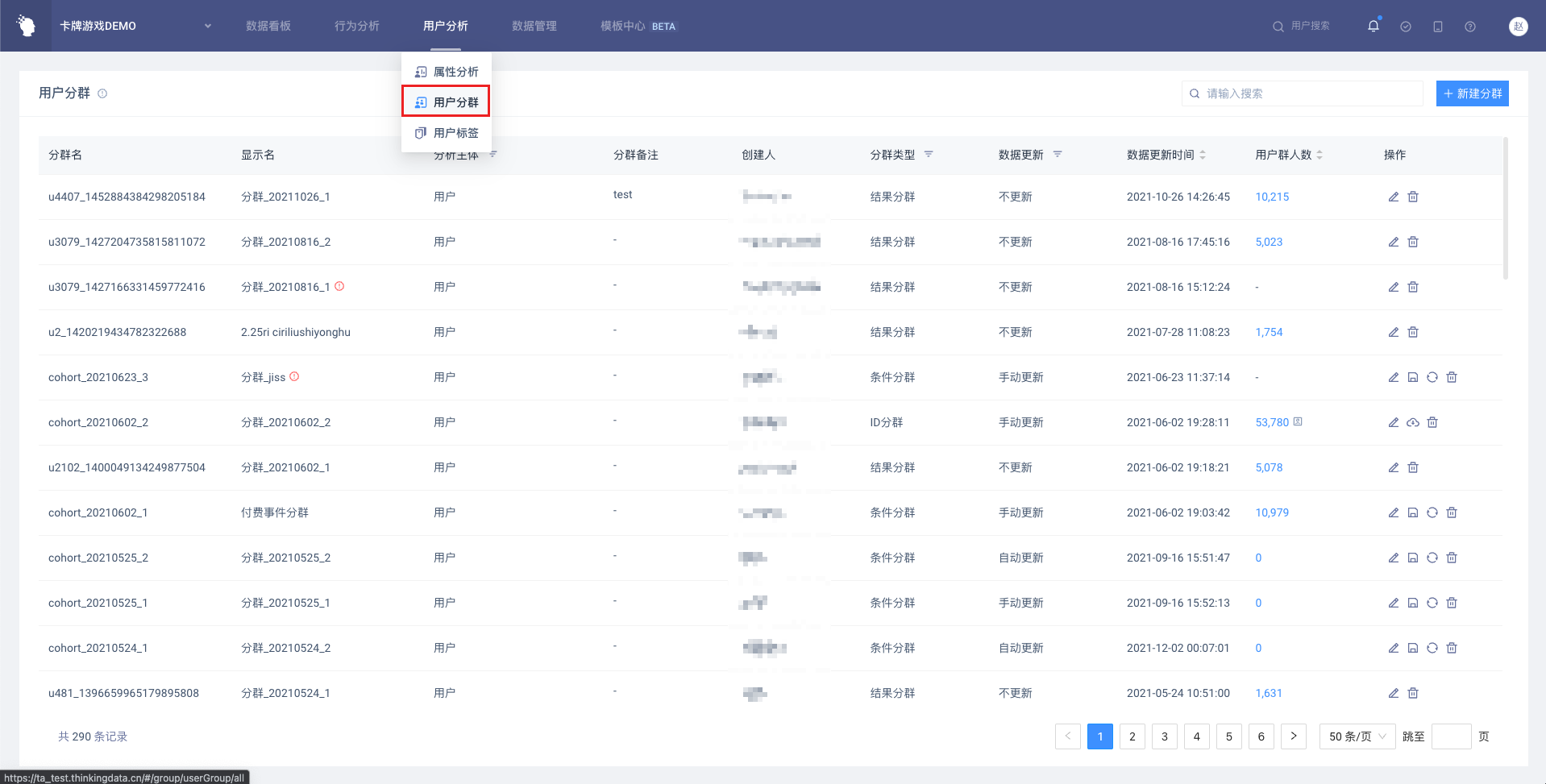
There are three types of user groups: conditional groups, ID groups, and result groups.
| Company Supervisor | Administrator | Analyst | Ordinary members | |
|---|---|---|---|---|
| View group list | ● | ● | ● | ○ |
| Add, edit, delete self-built condition/ID groups | ● | ● | △ | ○ |
| Add, edit, delete self-built result groups | ● | ● | ▲ | ○ |
| Edit and delete other people's groups | ● | ○ | ○ | ○ |
Permission description:
● Role must have
▲ The role has the permission by default, but can revoke
△ The role is not available by default, but can be authorized
○ Role must not have
# III. Overview of User Groups Page
The 'basic information list' of groups, the 'search control', and the 'creat new group' button.

# IV. Usage of User Groups
# 4.1 List of Basic Information of Groups
The group list will display the group name, display name, analysis subject, group comments, creator, group type, data update, data update time, number of users, operation bar.
Click 'Number of Users' to view the list of users (analysis subjects) corresponding to the group, and the operation bar can perform different setting operations according to different group types:
| Group type | Action item |
|---|---|
| Conditional group | View/edit grouping, refresh calculations, delete |
| ID group | View/edit grouping, download grouping files, delete |
| Outcome group | Edit cluster name, delete |
Note: Relevant permission members in the project can view user groups created by other users and the corresponding list of users, but can only edit or delete user groups created by themselves.
# 4.2 Conditional Groups
# 4.2.1 New Conditional Groups
Click '+ New Group' at the top right of the group page and select 'New Conditional Group'(Note that there is an upper limit to the user group and creation cannot continue until the upper limit is reached).

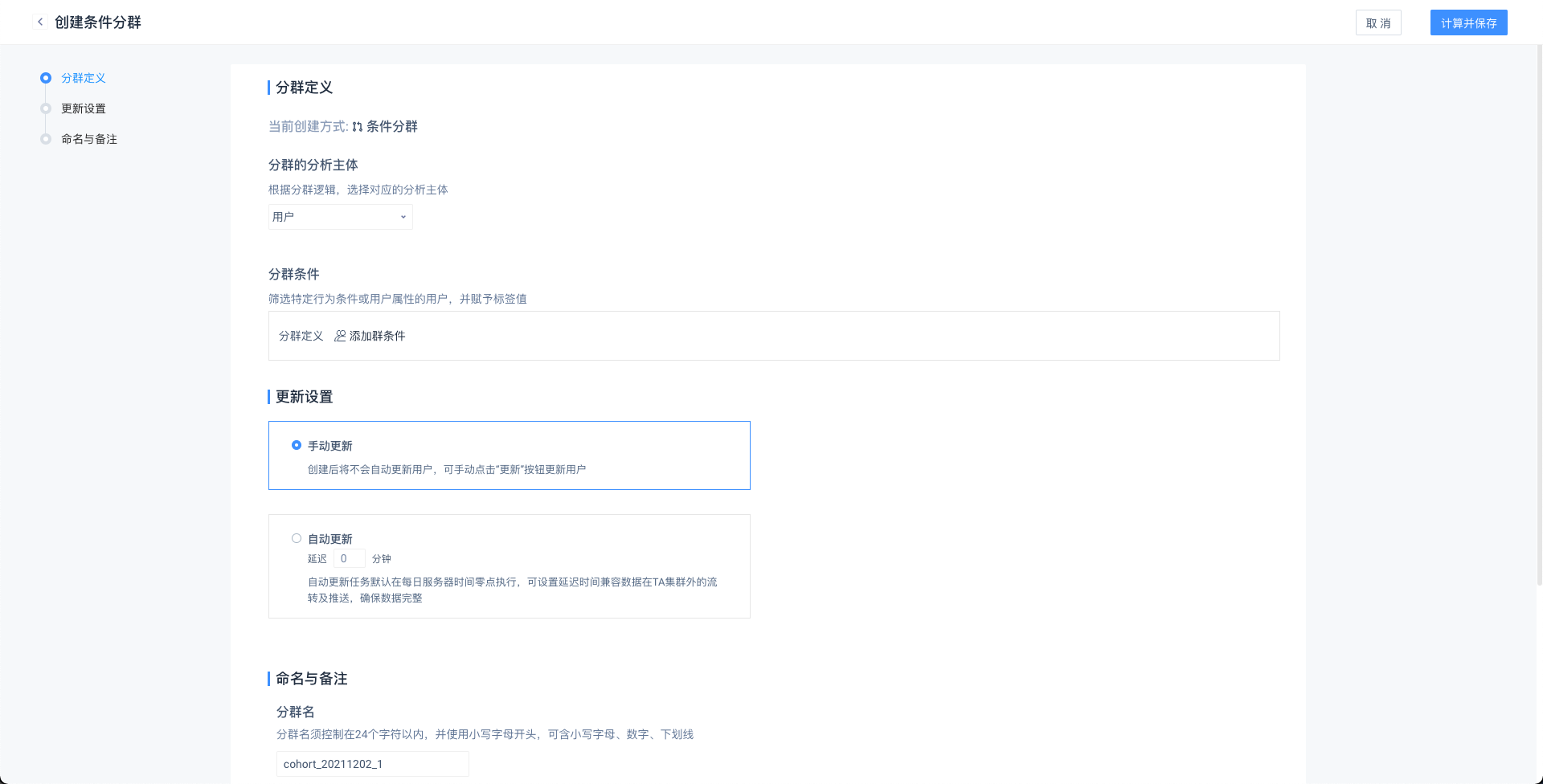
- Group Analysis Subject
According to the logic corresponding to groups, select the required analysis subjects, and after creation, the qualified analysis subjects will be jointed as user groups.
- Group Condition
There are two types of conditions that can be added: Events that have been done, Events that have not been done, or User Attributes that are satisfied, either of which can be added.

DANGER
If the source of the grouped analysis subject is the event attribute, only the 'done' condition can be selected, not the 'not done' condition, nor the 'user feature satisfied' condition can be selected. At the same time, the event drop-down list only contains events with this attribute.
- When selecting 'done an event' , the analysis direction that can analyze the event is as follows:
| Event description | Indicator description (data type) | Analysis direction |
|---|---|---|
| Arbitrary event | Total number of times, total number of days | |
| Meta event | Total number of times, total number of days | |
| Meta event | Event properties (numeric) | Sum, mean, maximum, minimum, deduplicate number |
| Meta event | Event properties (non-numeric) | Deduplicate number |
The results calculated from the analysis direction can be compared with fixed values, and the comparison logic supports : greater than, less than, equal to, not equal to, interval.
You can also filter event attributes.
| Property Marquee | Keywords |
|---|---|
| Event attribute (numeric) | Equal to, not equal to, less than, less than or equal to, greater than, greater than or equal to, with value, without value, interval |
| Event attribute(text) | Equal to, not equal to, include, not include, have value, have no value, regular match, regular mismatch |
| Event attribute (list) | Existing element, non-existing element, element location, value, no value |
| Event attribute (time) | Located in interval, less than or equal to, greater than or equal to, relative to current date, relative to event occurrence time, with value, without value |
| Event attribute (Boolean) | True, false, valuable, worthless |
| Event attribute (objects) | Value, no value |
| Event attribute (object group) | Existing object satisfies, no object satisfies, all objects satisfy, has value, has no value |
- You can also filter user features :
| Property Marquee | Keyword |
|---|---|
| User features(numeric) | Equal to, not equal to, less than, less than or equal to, greater than, greater than or equal to, with value, without value, interval |
| User feature ( text ) | Equal to, not equal to, including , not including , valuable, worthless, regular match, regular mismatch |
| User feature (list) | Existing element, non-existing element, element location, value, no value |
| User feature (time) | In interval, less than equal, greater than equal, relative to current date, with value, without value |
| User feature (Boolean) | True, false, valuable, worthless |
| User features(objects) | Value, no value |
| User feature (object groups) | Existing object satisfies, no object satisfies, all objects satisfy, has value, has no value |
Conditional group can choose two update methods, 'manual update' and 'automatic update':
'Manual update' means that after the first calculation is completed, the system will not automatically update the user group, and the user needs to update manually.

'Automatic Update' will update the user group after TA server 0 o'clock, the previous day as a benchmark . You can set the update delay to ensure that all the data of the previous day is received to ensure data integrity.

TIP
A project supports the creation of 200 conditional groups . You can contact TA staff to increase the maximum number of groups.
# 4.2.2 View, Edit and Delete of Conditional Groups
You can click the 'Group Definition' button to enter the group setting page to view the group setting conditions.
Enter the group settings page, if you have editing permissions, you will directly enter the editing state.
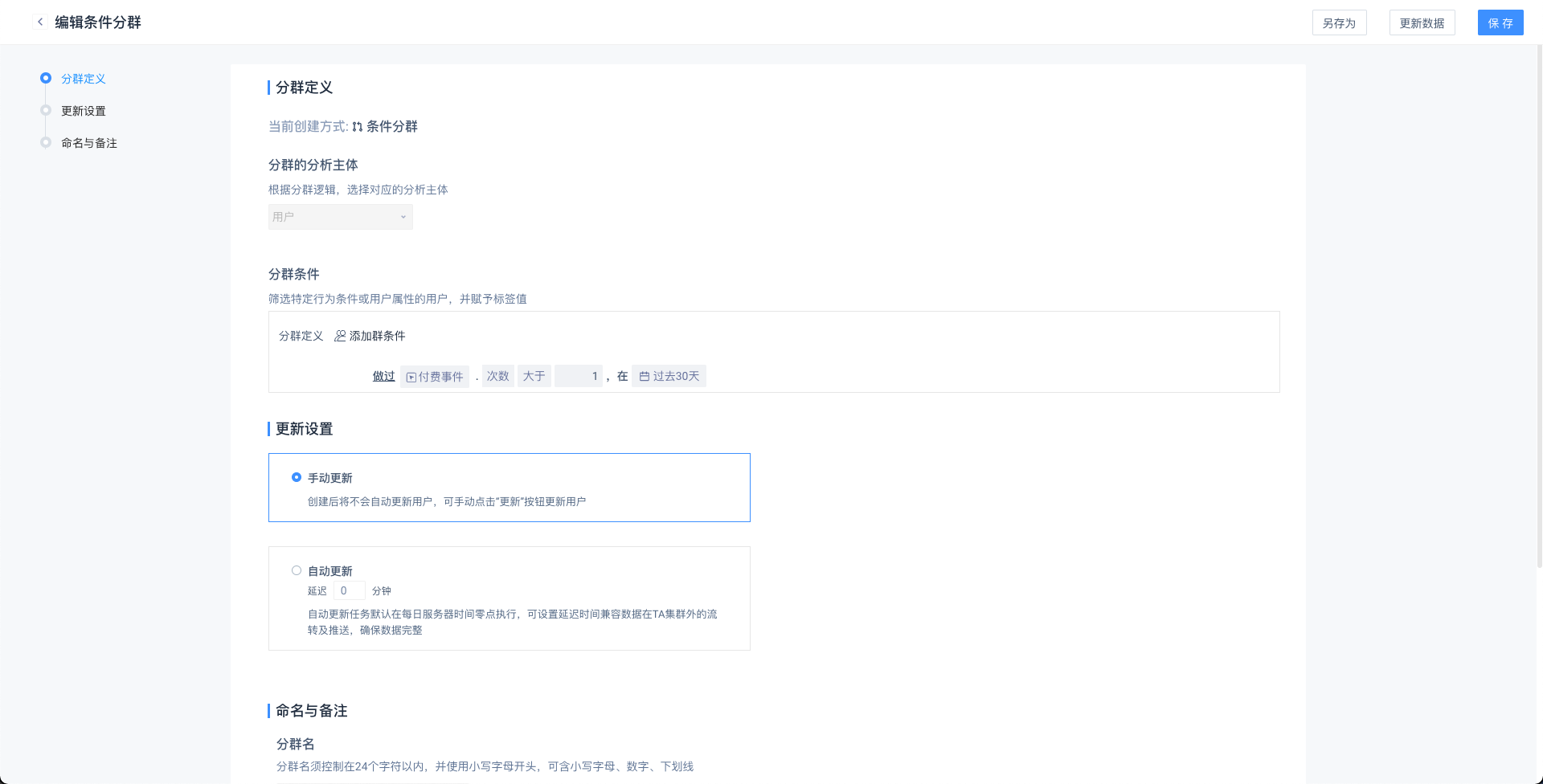
General users can only edit and update the user groups they create; Company supervisors can edit and update any user-created user group.
The general users can only delete the conditional group they created, and those not created by themselves will not display the deletion button or delete it.; Company supervisors can delete any user group created by the user.
# 4.3 ID Groups
# 4.3.1 New ID Groups
Click '+ New Group' at the top right of the group page, and select 'Upload ID Group"
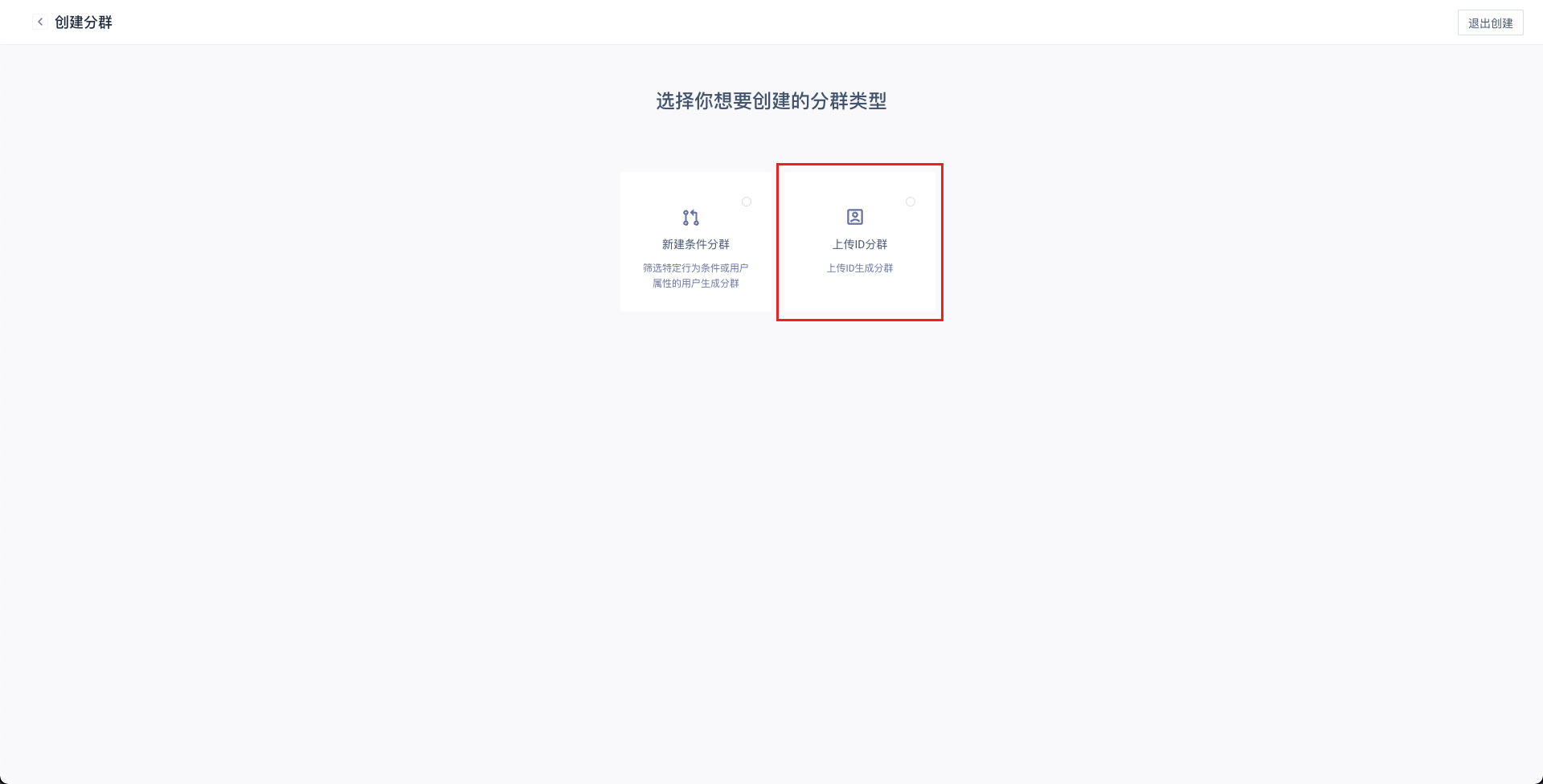
Go to the create page , select the groupded analysis subject and upload the file.
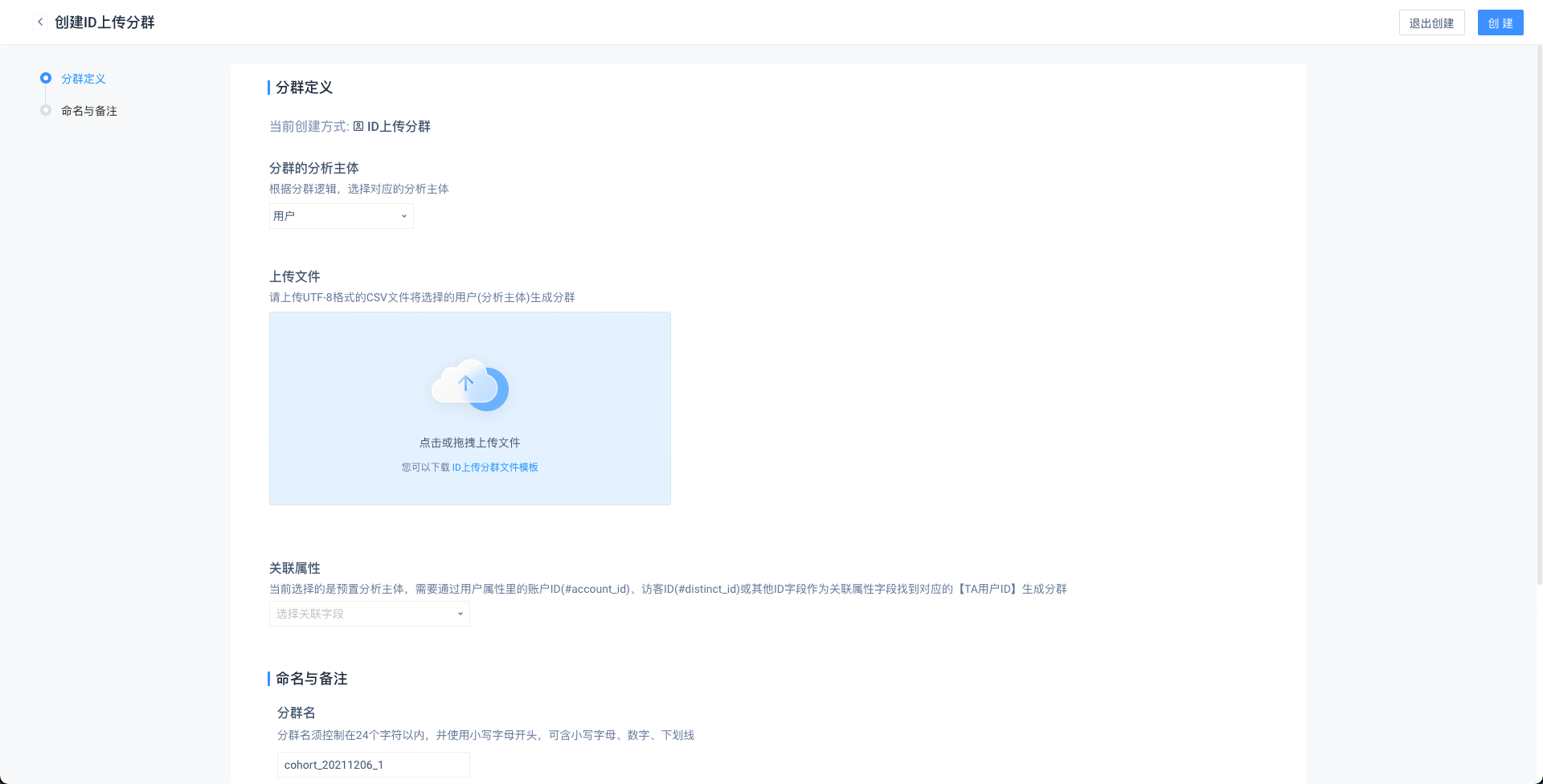
- The format requirements of the uploaded file are: each line in the ID file records an ID field, which is recorded in UTF-8 encoded CSV text format ; You can click on the blue text to download the template.
- ID upload type tag, can not set 'update metho' and 'backup method'.
If the analysis subject selects the TA user ID (#user_id), a user feature (numerical value or text type) can be selected as the associated field to judge the user, and the TA user ID that meets the selected user feature value (first column) at the time of uploading will be given the corresponding tag value.
If other analysis subjects are selected, the first column in the uploaded file will be directly used as the analysis subject ID, and whether the corresponding ID exists in the currently reported data will not be verified. Please check carefully before uploading..
For example: take the district service ID as the analysis subject, assuming that the current game is only open to the 60th district service, the uploaded file can still use 61, 62... As the analysis principal ID.
TIP
Each user supports uploading 50 ID groups , and after reaching the upper limit, you can continue to add new groups by deleting existing ID groups.
# 4.3.2 View, Edit and Delete ID Group
You can click the 'Group Definition' button to enter the group setting page to view the group setting conditions.
Enter the group settings page. If you have editing permission, you will directly enter the editing state.
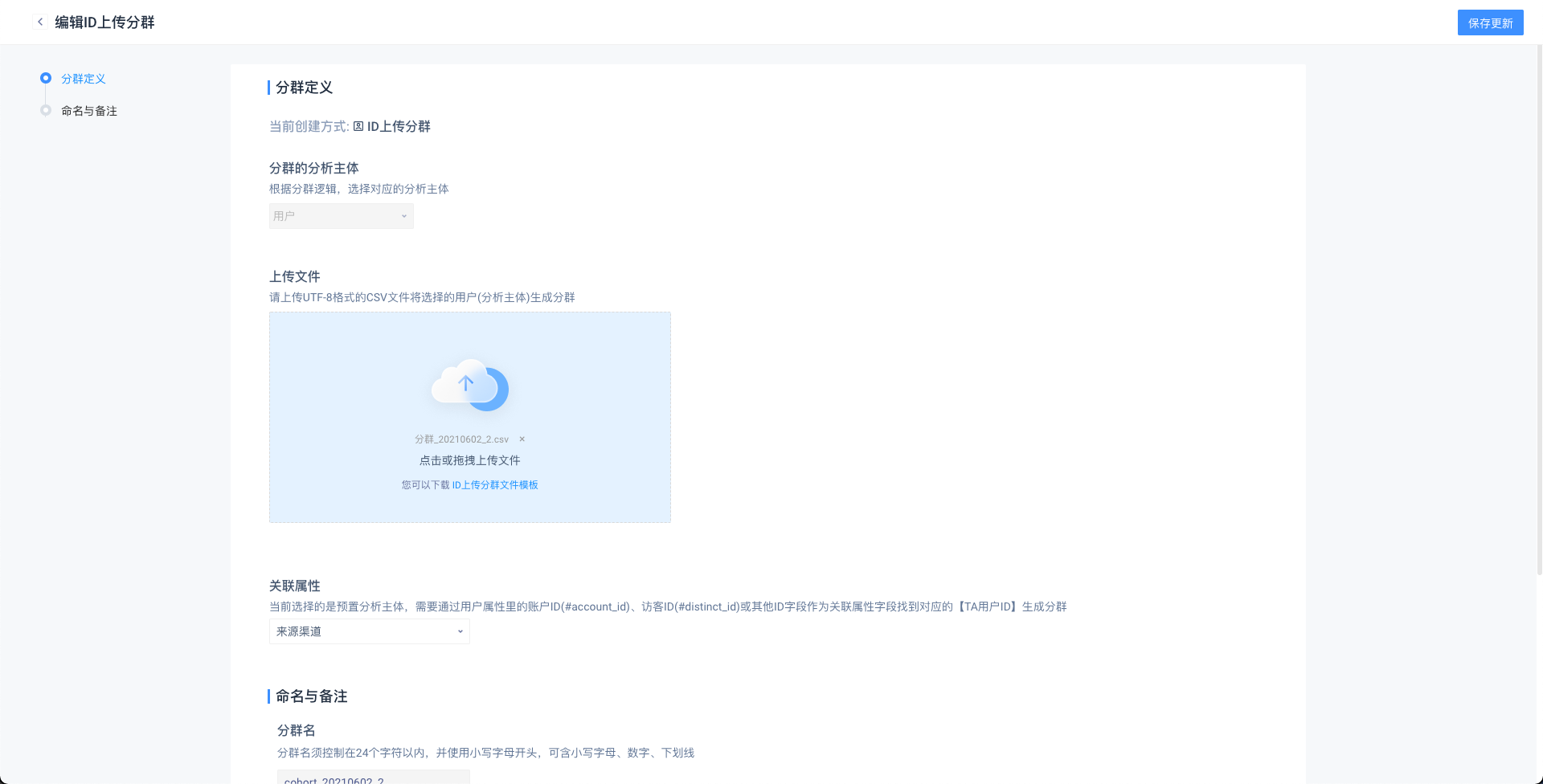
General users can only edit and download ID groups they create; Company supervisors can edit and download any user-created ID groups.
The general users can only delete the ID group they created, and those not created by themselves will not display the deletion button or delete it.; Company supervisors can delete any user group created by the user.
# 4.4 Results Groups
# 4.4.1 New Result Groups
In the event analysis model, if the number of trigger users is calculated, the group can be created by clicking 'Create result group' in the result table.
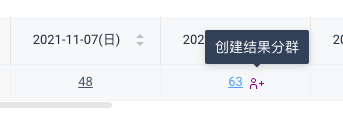
If it is a flow analysis model, you need to click to enter the view node details before the create result group button appears.
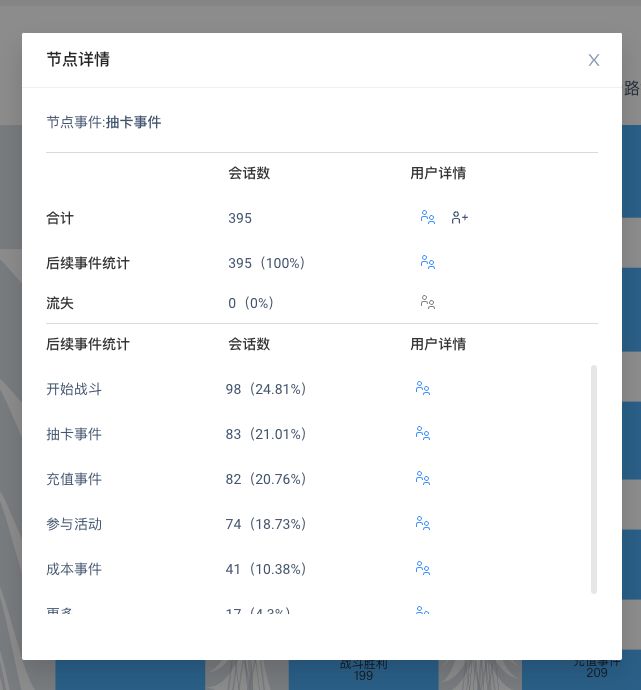
For other models such as retention analysis, you can click to create result group wherever the button appears in the table.
- The analysis subject corresponding to the result grouping created in different scenarios may be different. For example, when the account ID is used to calculate the retention model, the analysis subject of the result group created is the account ID.
- When creating a group, you can set the name and comment of the result group to form a description of the result group.
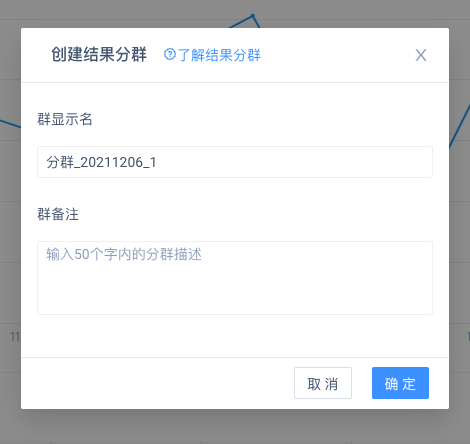
TIP
Each user can create 50 result groups. After reaching the upper limit, they can continue to add new groups by deleting existing result groups.
# 4.4.2 Editand Delete of Result Group
- The result group cannot modify the creation rules and update methods , only the name and comments of the group can be modified.
- The general users can only delete the result groups created by themselves, and the user groups not created by themselves will not display the delete button and cannot be deleted; Company superviosrs can delete any user group created by the user.
# 4.5 User Group List
Click on the 'number of users' of a group in the group list to enter the user list page, which displays qualified user list information.
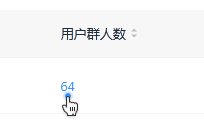
Enter the User List page and you will see the user details for the group and be able to download it.
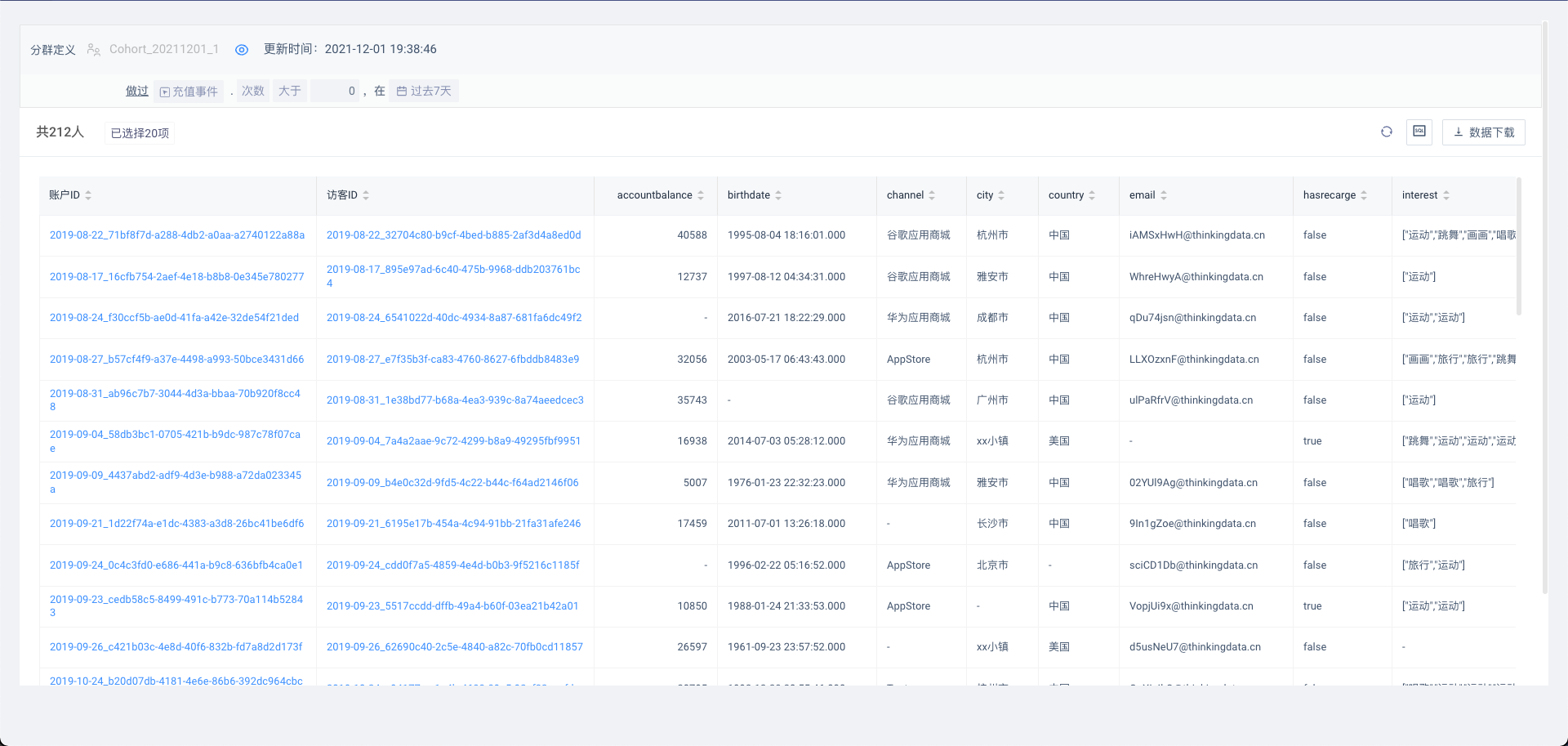
- If it is a conditional group, the definition conditions of the user group will be displayed. Click 'View icon' to fold the group definition; other group types will not display the group definition.
- The total number of people in the base group, user features, and data for up to 1000 users will be displayed on the list.
- You can select the user features displayed in the list through the user feature dropdown menu in the attribute filter area, and the tick box of attributes will display. As with the user list, you can select basic user features, virtual user features, and dimension table user features in the attribute filter area.
- The downloaded data is consistent with the table filter column, and the complete user data of the group will be downloaded (the maximum number of data is 500,000).
# V. Best Applications
# 5.1 Acquire High-value Users
Conditional groups can create groups through user-generated behaviors, which is very suitable for creating groups based on important behaviors and also for high-value users.
For example, over a period of time, high-value users of payment activities can be acquired if the payment amount is greater than one. Through the analysis of these users, the main characteristics of high-value users can be analyzed.
# 5.2 Exclude Specific Users
ID groups come from the ID list file, which can exist or download the result file of SQL query, and is often used to exclude specific users.
For example, you can create a group of internal test accounts through an ID list, or you can calculate users with abnormal behavior through a SQL query, download the result file, create an ID group, and exclude it through filtering condition during analysis.
# 5.3 Drill-down Analysis
The result groups are derived from the analysis results, so it is very suitable for clustering the results of a certain analysis as the foundation of drill-down analysis.
For example, by calculating participation in a payment event through distribution analysis, a clear polarization is observed, i.e. users are mainly focused on participation once or twice and participation many times. Then it is very suitable to create two result groups for the users of these two sections based on the analysis results, to drill down the analysis of the two groups, or to combine the two groups.
# 5.4 Groups Export
In addition to being used in TA groups, groups can also be used in external systems through export.
For example, if players with potential cheating are calculated, they can be banned by exporting them in groups. Similarly, users with loss tendencies can be calculated or can export to develop targeted operational strategies.
For more information on how to export in groups, see the Grouping API section of the OPEN API.
